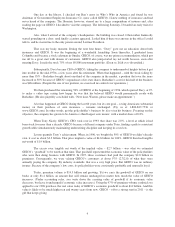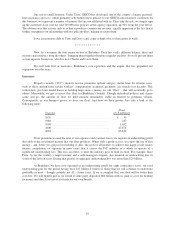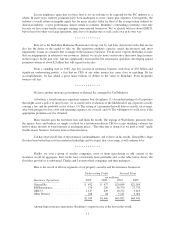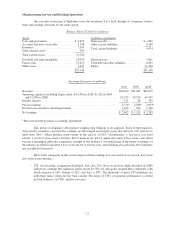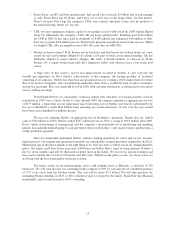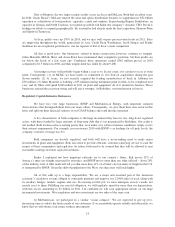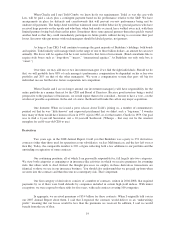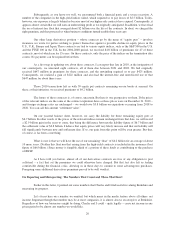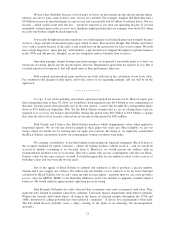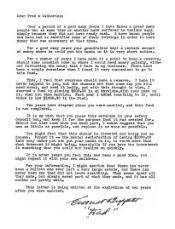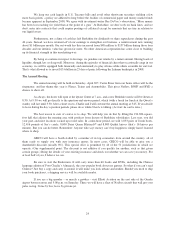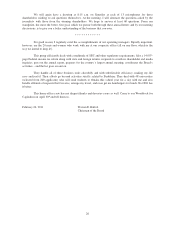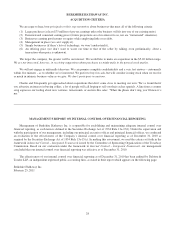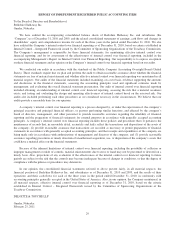Berkshire Hathaway 2010 Annual Report Download - page 21
Download and view the complete annual report
Please find page 21 of the 2010 Berkshire Hathaway annual report below. You can navigate through the pages in the report by either clicking on the pages listed below, or by using the keyword search tool below to find specific information within the annual report.When Charlie and I met Todd Combs, we knew he fit our requirements. Todd, as was the case with
Lou, will be paid a salary plus a contingent payment based on his performance relative to the S&P. We have
arrangements in place for deferrals and carryforwards that will prevent see-saw performance being met by
undeserved payments. The hedge-fund world has witnessed some terrible behavior by general partners who have
received huge payouts on the upside and who then, when bad results occurred, have walked away rich, with their
limited partners losing back their earlier gains. Sometimes these same general partners thereafter quickly started
another fund so that they could immediately participate in future profits without having to overcome their past
losses. Investors who put money with such managers should be labeled patsies, not partners.
As long as I am CEO, I will continue to manage the great majority of Berkshire’s holdings, both bonds
and equities. Todd initially will manage funds in the range of one to three billion dollars, an amount he can reset
annually. His focus will be equities but he is not restricted to that form of investment. (Fund consultants like to
require style boxes such as “long-short,” “macro,” “international equities.” At Berkshire our only style box is
“smart.”)
Over time, we may add one or two investment managers if we find the right individuals. Should we do
that, we will probably have 80% of each manager’s performance compensation be dependent on his or her own
portfolio and 20% on that of the other manager(s). We want a compensation system that pays off big for
individual success but that also fosters cooperation, not competition.
When Charlie and I are no longer around, our investment manager(s) will have responsibility for the
entire portfolio in a manner then set by the CEO and Board of Directors. Because good investors bring a useful
perspective to the purchase of businesses, we would expect them to be consulted – but not to have a vote – on the
wisdom of possible acquisitions. In the end, of course, the Board will make the call on any major acquisition.
One footnote: When we issued a press release about Todd’s joining us, a number of commentators
pointed out that he was “little-known” and expressed puzzlement that we didn’t seek a “big-name.” I wonder
how many of them would have known of Lou in 1979, Ajit in 1985, or, for that matter, Charlie in 1959. Our goal
was to find a 2-year-old Secretariat, not a 10-year-old Seabiscuit. (Whoops – that may not be the smartest
metaphor for an 80-year-old CEO to use.)
Derivatives
Two years ago, in the 2008 Annual Report, I told you that Berkshire was a party to 251 derivatives
contracts (other than those used for operations at our subsidiaries, such as MidAmerican, and the few left over at
Gen Re). Today, the comparable number is 203, a figure reflecting both a few additions to our portfolio and the
unwinding or expiration of some contracts.
Our continuing positions, all of which I am personally responsible for, fall largely into two categories.
We view both categories as engaging us in insurance-like activities in which we receive premiums for assuming
risks that others wish to shed. Indeed, the thought processes we employ in these derivatives transactions are
identical to those we use in our insurance business. You should also understand that we get paid up-front when
we enter into the contracts and therefore run no counterparty risk. That’s important.
Our first category of derivatives consists of a number of contracts, written in 2004-2008, that required
payments by us if there were bond defaults by companies included in certain high-yield indices. With minor
exceptions, we were exposed to these risks for five years, with each contract covering 100 companies.
In aggregate, we received premiums of $3.4 billion for these contracts. When I originally told you in
our 2007 Annual Report about them, I said that I expected the contracts would deliver us an “underwriting
profit,” meaning that our losses would be less than the premiums we received. In addition, I said we would
benefit from the use of float.
19


